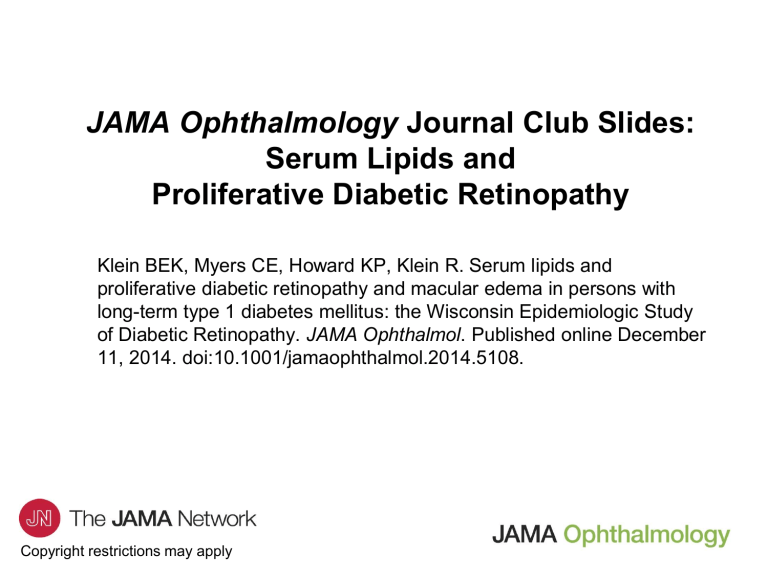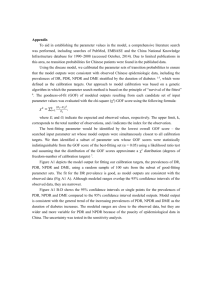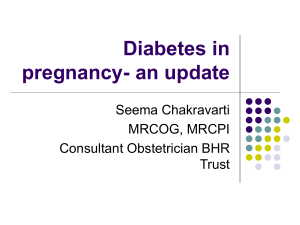Journal Club Slides - JAMA Ophthalmology

JAMA Ophthalmology Journal Club Slides:
Serum Lipids and
Proliferative Diabetic Retinopathy
Klein BEK, Myers CE, Howard KP, Klein R. Serum lipids and proliferative diabetic retinopathy and macular edema in persons with long-term type 1 diabetes mellitus: the Wisconsin Epidemiologic Study of Diabetic Retinopathy. JAMA Ophthalmol . Published online December
11, 2014. doi:10.1001/jamaophthalmol.2014.5108.
Copyright restrictions may apply
Introduction
• Proliferative diabetic retinopathy (PDR) and macular edema (ME) are important causes of decreased vision in persons with type 1 diabetes mellitus.
• Serum lipids have been found to be associated with the incidence and progression of lesions of diabetic retinopathy.
• Long-term follow-up with several periodic visits provides a perspective on the relationship of lipid levels to the incidence of vision-threatening retinal lesions.
Copyright restrictions may apply
Methods
• The Wisconsin Epidemiologic Study of Diabetic Retinopathy is a population-based study of persons receiving care for diabetes in an 11county area of Wisconsin begun in 1978.
• 996 persons with type 1 diabetes mellitus were enrolled at baseline.
• Medical history, blood pressure, height, weight, medication use, and blood samples were obtained at each of 7 visits about 5 years apart.
• Serum total and high-density lipoprotein (HDL) cholesterol levels were determined from the second examination (1984-1986) for 4 additional examinations (most recent 2012-2014).
• Fundus photographs were taken at 5 visits.
Copyright restrictions may apply
Methods
• Seven standard stereoscopic fields of each eye after dilation.
• Graded according to modified Early Treatment Diabetic Retinopathy (ETDRS) protocols.
• Generalized estimating equations were used to analyze the effect of risk factors on prevalence of eye disease to account for correlation between visits.
• Multilevel modeling was used to examine incidence between examinations, accounting for unequal spacing between examinations.
• Risk variables were updated at each time.
• All models were adjusted for diabetes duration, glycosylated hemoglobin
(hemoglobin A
1c
) level, and statin use.
Copyright restrictions may apply
Results
• 819 participants (400 women and 419 men) contributed 2319 person-visits to the analyses for the prevalence of PDR or ME; 520 participants (269 women and 251 men) contributed 1146 person-visits to the analyses for incidence of
PDR or ME.
• In respective prevalence and incidence analyses, mean duration of diabetes was 27.7 and 22.8 years; mean hemoglobin A
1c was 8.7% and 8.8; and regular statin use was reported by 20.5% and 7.4%.
• For PDR, estimated prevalence was 41.0% per person-visit and estimated incidence was 1.21% per person-year; for ME, estimated prevalence was
23.8% per person-visit and estimated incidence was 0.77% per person-year.
• Effects of adjustment:
– Duration of diabetes and hemoglobin A
1c of the lipids in the models.
in general decreased the effects
– Statin use had no significant additional effects.
Copyright restrictions may apply
Results
Prevalent PDR by Lipid Levels
Prevalent PDR by Cholesterol Odds Ratio for Prevalent PDR*
*Adjusted for diabetes duration, hemoglobin A
1c
, and statin use.
Copyright restrictions may apply
Results
Prevalent ME by Lipid Levels
Prevalent ME by Cholesterol Odds Ratio for Prevalent ME*
*Adjusted for diabetes duration, hemoglobin A
1c
, and statin use.
Copyright restrictions may apply
Results
Incident PDR by Lipid Levels
Incident PDR by Cholesterol Odds Ratio for Incident PDR*
*Adjusted for diabetes duration, hemoglobin A
1c
, and statin use.
Copyright restrictions may apply
Results
Incident ME by Lipid Levels
Incident ME by Cholesterol Odds Ratio for Incident ME*
*Adjusted for diabetes duration, hemoglobin A
1c
, and statin use.
Copyright restrictions may apply
Comment
• Higher HDL cholesterol was associated with lower prevalence of PDR.
• Higher total cholesterol was associated with greater prevalence of ME.
• Higher total and HDL cholesterol was associated with higher incidence of ME.
• Limitations:
– Decreased sample size at more recent visits.
– Selective survival in persons with long duration of diabetes may be responsible for limited ability to detect associations with serum lipid levels.
– Low use of statins in the early visits of the Wisconsin Epidemiologic Study of Diabetic Retinopathy may have limited the ability to detect independent effects of this class of medications.
Copyright restrictions may apply
Contact Information
• If you have questions, please contact the corresponding author:
– Barbara E. K. Klein, MD, MPH, Department of Ophthalmology and
Visual Sciences, University of Wisconsin –Madison, 610 N Walnut St,
409 WARF, Madison, WI 53726-2336 (kleinb@epi.ophth.wisc.edu).
Funding/Support
• This research was supported by grant EY016379 from the National
Institutes of Health (Drs R. Klein and B. E. K. Klein) and an unrestricted grant from Research to Prevent Blindness, New York, New York.
Conflict of Interest Disclosures
• None reported.
Copyright restrictions may apply









